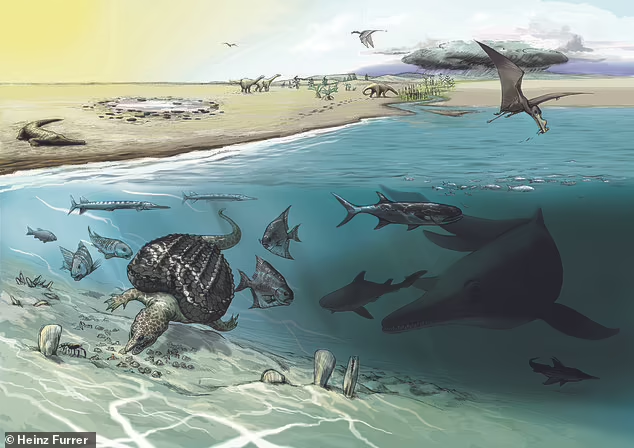Remains of a giant sea monster, that lived 205 million years ago, have been found 9,000 feet above sea level in the Swiss Alps by a team of archaeologists.
The marine monster grew to a length of 65ft and weighed 80 ton, and was identified from fossils representing three individuals - including teeth, ribs, and vertebrae.
The 205 million year old ichthyosaur was discovered in the Swiss Alps by a team from the University of Zurich, who described the find as 'thrilling'.
They were dug out of rocks 9,000 feet above the ocean in Switzerland, where Europe's high peaks formed when tectonic plates collided - pushing up the seabed.
The huge reptiles patrolled Panthalassa, an ocean that surrounded the supercontinent Pangea during the Late Triassic.
Team member Dr Heinz Furrer, a retired curator at the University of Zurich's Palaeontological Institute and Museum, said he was thrilled by the discovery.
He said: 'It's the world's longest ichthyosaur; with the thickest tooth found to date and the largest trunk vertebra in Europe.'
These massive creatures also made forays into the shallow seas of the Tethys on the eastern side of Pangea, the team discovered.
Lead author Dr Martin Sandler, of the University of Bonn, said: 'Maybe there are more remains of the giant sea creatures hidden beneath the glaciers.'
They discovered teeth and vertebrae from the 65ft long, 80 ton ichthyosaurs, and the tooth root was twice as wide as the previous record, which belonged to another ichthyosaur that was 50 feet from nose to tail.
Dr Sandler said: 'Bigger is always better. There are distinct selective advantages to large body size. Life will go there if it can.
'There were only three animal groups that had masses greater than 10–20 metric tonnes: long-necked dinosaurs; whales; and the giant ichthyosaurs of the Triassic.'
Ichthyosaurs first emerged in the wake of the Permian extinction some 250 million years ago, when some 95 per cent of marine species died out.
The group reached its greatest diversity in the Middle Triassic - and a few species persisted into the Cretaceous.
Roughly the shape of contemporary whales, ichthyosaurs had elongated bodies and erect tail fins.
Fossils are concentrated in North America and Europe, but ichthyosaurs have also been found in South America, Asia, and Australia.
Giant species have mostly been unearthed in North America, with scant finds from the Himalaya and New Caledonia.
The discovery of further behemoths in Switzerland represents an expansion of their known range.
Dr Sander said: 'It amounts to a major embarrassment for palaeontology that we know so little about these giant ichthyosaurs despite the extraordinary size of their fossils. We hope to rise to this challenge and find new and better fossils soon.'
The specimens, collected between 1976 and 1990, have only recently been scanned, and likely represent the last of the leviathans.
Dr Sander said: 'In Nevada, we see the beginnings of true giants, and in the Alps the end. Only the medium-to-large-sized dolphin and orca-like forms survived into the Jurassic.'
It's only the second instance of a giant ichthyosaur with teeth - the other being the 50 foot long Himalayasaurus.
They occupied similar ecological roles to modern sperm whales and killer whales, the team explained, adding that the teeth are curved inwards like those of their mammalian successors.
It indicates a grasping mode of feeding conducive to capturing prey such as giant squid.
Dr Sander said: 'It is hard to say if the tooth is from a large ichthyosaur with giant teeth or from a giant ichthyosaur with average-sized teeth.'
The tooth was broken off at the crown. It could not confidently be assigned to a particular taxon.
Still, a peculiarity of dental anatomy allowed the researchers to identify it as belonging to an ichthyosaur.
Dr Sander said: 'Ichthyosaurs have a feature in their teeth that is nearly unique among reptiles: the infolding of the dentin in the roots of their teeth. The only other group to show this are monitor lizards.'
The skeletal remains consist of eight vertebrae and ten rib fragments. They belong to the family Shastasauridae, which contains the giants Shastasaurus, Shonisaurus and Himalayasaurus.
Known as the Kössen Formation, the rocks from which these fossils derive were once at the bottom of a shallow coastal area - a very wide lagoon
The findings have been published in the Journal of Vertebrate Paleontology.












